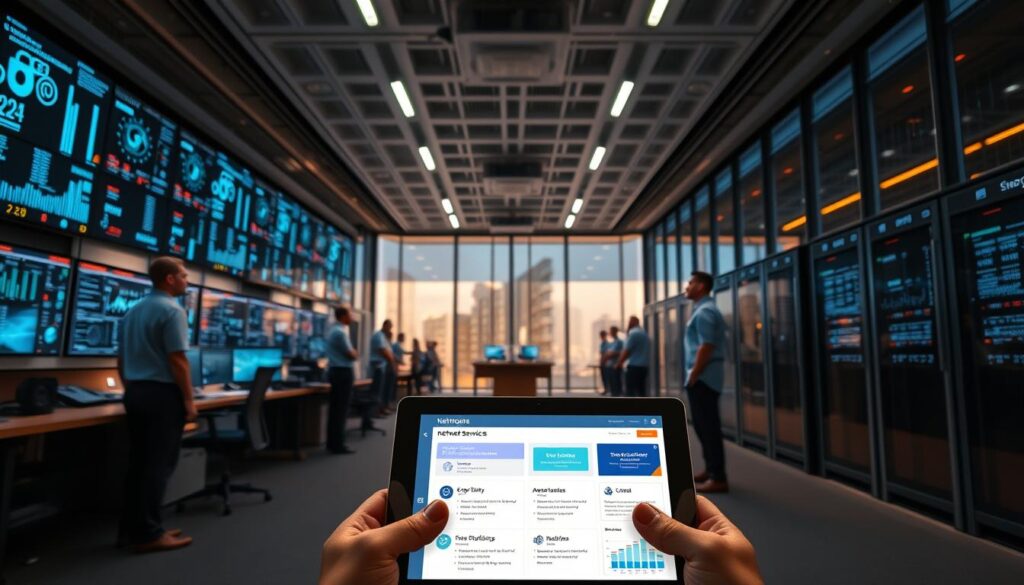2026 brings sharper threats and higher stakes for local firms. Ransomware, account takeover, unauthorized access, supply chain and insider risks can halt operations fast. A layered defense model that blends people, process, and technology keeps firms running and limits downtime.
Proven local outcomes matter. Providers here report protecting 200+ Wasatch Front companies, resolving over 1,000,000 tickets, and running 24/7 MDR with incident response, EDR/NGAV, SIEM, MFA, and training. Another firm secures 50+ businesses and 1,453 endpoints with a 24/7 SOC, rapid response, and streamlined onboarding that shortens time to value.
This guide links those real-world results to practical services and solutions. You’ll see how each core threat maps to specific controls and how risk-based prioritization aligns protection with business needs and budgets.
Key Takeaways
- Defense-in-depth reduces downtime and speeds incident containment.
- Local providers deliver tested playbooks, rapid response, and 24/7 monitoring.
- Five threat categories map directly to controls like EDR, SIEM, MFA, and training.
- Risk-based investment keeps protection aligned with business priorities and budgets.
- Practical services and clear onboarding shorten time to measurable results.
The 2026 Cyber Risk Landscape for Utah Businesses
Rising attack volume and smarter tactics mean businesses must pair vigilance with fast detection to stay resilient.
Threats are more sophisticated and hit more targets as companies adopt SaaS, hybrid cloud, and third‑party integrations. That expands the attack surface and moves critical data outside traditional perimeters.
Always-on monitoring matters. Local providers report 24/7 SOC and SIEM oversight that correlates events across servers, email, endpoints, and cloud systems to spot early intrusion indicators.
Compliance and operations intersect. Teams help firms meet HIPAA, PCI, SEC, GLBA, and FINRA requirements by aligning controls to NIST-style frameworks and measurable policies.
Many breaches start with misconfigurations, missed patches, or social engineering. Regular assessments, user training, and patch management cut these risks and improve detection times.
When minutes matter, local support shortens response and limits downtime. A layered approach—people, process, and technology—protects infrastructure end-to-end and keeps business operations running.

- 24/7 monitoring + rapid detection reduce breach impact.
- Cloud governance and access controls lower exposure.
- Framework-driven controls link compliance to measurable outcomes.
Top Network Security Threats Affecting Utah Companies in 2026
Local businesses face a sharper mix of attacks in 2026 that test tech controls and people processes alike.
Ransomware and double‑extortion remain dominant. Attackers encrypt systems and exfiltrate data to pressure SMBs into paying. That combination hurts operations and creates legal exposure when sensitive records are leaked.
Ransomware and Double-Extortion Targeting SMBs
Many incidents start with email or an exposed remote service. EDR/NGAV, reliable backups, and rapid incident response cut dwell time and recovery costs.
Business Email Compromise and Account Takeover
BEC exploits weak authentication and user trust. Finance and HR workflows are common targets for fraudulent transfers and data harvesting. Enforcing MFA and advanced email filtering reduces success rates.
Unauthorized Access via Misconfigured VPNs and Remote Systems
Misconfigurations in VPNs and remote desktop services let attackers move laterally across systems. Daily configuration reviews and timely patching are simple, effective defenses.
Supply Chain and Third‑Party Risks Across Cloud and SaaS
Compromised vendors can cascade into local environments. Vendor risk assessments and minimum control baselines help limit exposure from third‑party services.
Insider Threats and Human Error Exploited by Phishing
Phishing amplifies both accidental and malicious insider actions. Ongoing training and simulation testing keep users vigilant and reduce human error.
- Daily email filtering, configuration reviews, and patching lower the chance of initial compromise.
- Continuous visibility and user-focused education are core to reducing impact across these threat categories.
Mitigation Strategies Mapped to Each Threat: Proven Security Services and Solutions
Practical defenses translate threat intelligence into action across people, processes, and tools.
24/7 SOC and SIEM link telemetry from endpoints, email, and cloud to spot early intrusion signs. Correlated alerts and expert triage shorten mean time to detection and mean time to response.
Endpoint Detection and Ransomware Containment
EDR and next‑gen AV use behavioral prevention and rollback to reduce ransomware blast radius. These tools stop malicious activity on endpoints and offer rapid recovery options.
Firewall Policies, Secure VPNs, and Continuous Monitoring
Firewall policy management, geo‑blocking, and secure VPN configuration limit unauthorized access and lateral movement. Continuous monitoring keeps infrastructure visibility high and flags anomalies fast.
Vulnerability Management and Remediation Tracking
Proactive scans, authenticated discovery, and risk‑based prioritization close exploitable gaps. Remediation SLAs and tracking ensure vulnerabilities get fixed on schedule.
User Training and Phishing Simulations
Regular awareness programs and simulated phishing harden the first line of defense. Over time, click rates drop and user reporting improves.
Cloud Controls, Backups, and Access Management
Least‑privilege policies, MFA/SSO, configuration baselines, and tested backups protect hybrid environments. Centralized logging supports forensic analysis and restores systems when needed.
Incident Response Planning and Recovery Support
Documented playbooks for ransomware, BEC, and unauthorized access enable swift containment. Expert teams provide forensic scoping and structured recovery support to restore operations.
Managed services from an experienced local company operationalize these controls end‑to‑end. That improves protection while freeing internal staff to focus on strategic priorities.

- 24/7 detection and triage to reduce dwell time
- Endpoint tools with prevention and rollback
- Vulnerability workflows and SLA‑driven remediation
network security utah Services Tailored to Your Industry, Size, and Compliance Needs
Local teams design practical programs that match your company goals and regulatory requirements. The onboarding path begins with an assessment and gap analysis. That produces prioritized controls that fit your industry, size, and needs.
Customized Protection for Utah Businesses: From Assessment to Ongoing Monitoring
Providers combine consulting with hands-on operations to deliver continuous management of controls. Offerings include MDR, firewall and VPN solutions, ongoing monitoring, and NIST-aligned programs for HIPAA, PCI, SEC, GLBA, and FINRA.
Threat Detection, Management, and Response Aligned to Your Risk Profile
Experts tune detections across endpoints, identity, email, and cloud to cut false positives. Vulnerability findings map to actionable remediation plans with ownership, timelines, and validation.

- Tailored onboarding: assess, prioritize, implement.
- Continuous support: consulting plus operational management.
- Scalable solutions: grow controls with branches, SaaS, and hybrid clouds.
- Clear reporting: keep executives informed while freeing technical staff.
This model minimizes disruption and steadily lifts cybersecurity maturity. Local presence paired with standardized playbooks reduces overhead and keeps protection consistent across sites.
Compliance, Risk Management, and Business Continuity for Utah Organizations
Effective compliance and continuity link technical controls to clear business outcomes. Frameworks and tested plans protect revenue, reputation, and daily operations while making audit readiness practical for internal teams.
Framework‑Driven Security: NIST‑Aligned Controls and Policy Development
NIST-based policies, standards, and procedures create a durable foundation for information protection and continuous improvement.
Teams map controls to processes so your systems follow repeatable rules. That reduces gaps and keeps evidence ready for auditors.
Regulatory Readiness: HIPAA, PCI, SEC, GLBA, FINRA Without the Hassle
Local experts translate regulatory text into practical technical and administrative safeguards.
Security services collect evidence, produce auditor-ready documentation, and maintain a clear trail of compliance activities.
Faster Time‑to‑Protection: Streamlined Onboarding and Measurable Outcomes
Risk registers, business impact analyses, and continuity plans tie risks to business priorities and recovery targets.
Thirty-day onboarding options accelerate protection with prioritized patches and controls while longer initiatives proceed on a schedule that avoids vendor lock-in.
- Measurable outcomes: fewer incidents, faster response, and closed findings tracked per service interval.
- Continuity measures: tested backups, recovery runbooks, and alternate communications to keep operations running.
- Local support and regular service cadence make compliance tasks manageable and sustainable for internal staff.
Why Partner with a Utah‑Based Security Team for Comprehensive Protection
A nearby team shortens the path from detection to recovery with hands-on response and local industry know-how. That combination speeds containment and preserves business continuity when incidents occur.
Local Expertise, Proven Processes, and Continuous Support
Local experts bring deep experience across regional verticals and compliance requirements. They understand what regulators and customers expect, which reduces audit friction and reputational risk.
Field teams and analysts provide 24/7 monitoring and threat detection through SOC and SIEM operations. Providers here secure 50+ businesses, protect 1,453+ endpoints, and support 200+ Wasatch Front companies with rapid response times.
“Rapid investigation and containment cut downtime and lower overall impact.”
Scalable Security Solutions that Evolve with New and Emerging Threats
Security solutions grow with your company—adding sites, apps, and hybrid systems without losing visibility. Experts tune detections, refine playbooks, and align workflows to business cycles for sustained protection.
Engagement models often include 30-day onboarding, a 60-day opt-out guarantee, and flexible contracting. That approach helps teams get started quickly and see measurable milestones in weeks, not months.
- Continuous support: 24/7 SOC monitoring and trained analysts.
- Fast response: rapid investigation and containment in as little as 10 minutes.
- Practical onboarding: quick deployment, clear milestones, and executive reporting for peace of mind.
Conclusion
Consistent detection, fast response, and tested playbooks keep operations running when incidents occur.
A layered approach across email, identity, endpoints, cloud, and network infrastructure reduces exposure to top 2026 threats. Local providers combine MDR with 24/7 SOC and SIEM, EDR/NGAV, firewall and VPN management, vulnerability management, training, and incident planning to protect systems and data.
These services deliver tuned detection, rapid response, and measurable outcomes. Align network security controls and management with business priorities, compliance, and risk tolerance for sustainable protection.
Get started with an assessment, prioritized rollout, and validation testing. Partnering with a local company that offers clear SLAs and reporting brings expert support, lower operational burden, and peace of mind.
Consistent monitoring, detection, and response are essential to stay ahead of evolving threats and keep your company resilient.

